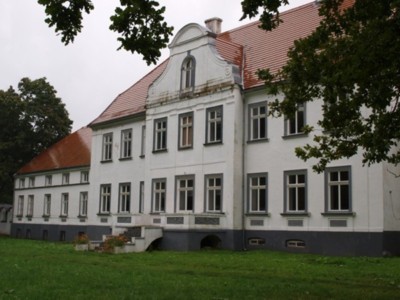
East Prussia - travelling ancient past and the origin of the Trakehner

The Trakehner castle, former "Landstallmeisterhaus"
It was a 9-days journey by ship and bus and something I had always wanted to do:
travelling East Prussia, former home of the Trakehner breed and it’s origins,
the 300 year old “leftovers” (ruins, so to speak) still proving the famous East
Prussian days of fame and glory.
In 1732 Prussian king
Friedrich Wilhelm the first commanded the development
of one big royal state stud in East Prussia in order to centralize breeding
efforts of the mostly desired cavallerie horses. More than 1000 horses moved
into the newly built Trakehnen initially and as many people were counted on the
list of employees. In 1944 WWII set an end to the East Prussian glory of
Trakehnen and some 800 Trakehner horses and with them the remaining population
of Trakehnen left their homes heading west – refugees they had become.
Former Trakehnen, part of the greater Kaliningrad (former Koenigsberg) area, has
become a part of Russia and is now called Jasnaja Poljana. The intact parts of
Jasnaja Poljana have become home of a Russian school. In 1993 the “Verein der
Freunde und Förderer des ehemaligen Hauptgestüts Trakehnen e.V.” (in brief:
Trakehnen Verein) has been founded in order to help and support the people of
Jansaja Poljana and the reminders of their historic buildings and provide for
grounds of common understanding of history and meaning of former Trakehnen
amongst the young russian students.

End of August the Trakehnen Verein started it's annual journey to visit
Trakehnen:
a huge ferryboat took us from Kiel harbour in Schleswig Holstein/Germany
crossing the Baltic Sea – 24 hours later we reached Klaipeda (former Memel)
nowadays
capitol of Lithuania. We travelled the Courland Spit (“Kuhrische
Nehrung”), following historic patterns many of the former refugees had to take
crossing the backwaters (“Haff”) of the frozen Baltic Sea.
Not knowing anything about Lithuania and the land as such one simply turns
breathless at it’s beauty and charme:
the coast facing the Baltic Sea is wild and yet inviting at the same time and
used to be a popular holiday
location even in Russian times, even though not many could
afford to go there back than. The coast facing the backwaters (“Haff”) is home
of the most pictorial villages you can imagine, and while it’s traditional
establishment is surely owed to fishermen today it is one of the most popular
vacation places in Lithuania. A neat inviting place lacking modern pomp and
glitter. The former home of german writer Thomas Mann (“The Buddenbrooks”) can
still be visited in neat Nidden as it has been turned into a museum.
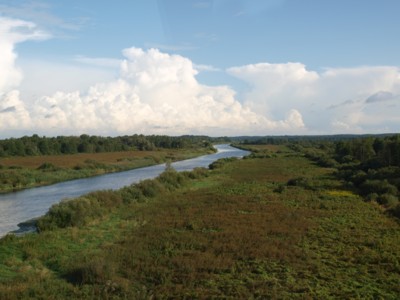
 The
Courland Spit is split up between Lithuania and Russia. Crossing the russian
border opens up a completely different world.
The
Courland Spit is split up between Lithuania and Russia. Crossing the russian
border opens up a completely different world.
Most fertile agricultural grounds as far as the eye sees – completely left
undone at uncontrolled growth. The former “granary” of the preussian empire
produces nothing but endless wilderness. The river Pregel (one of the Trakehner
foundation stallions was named after this river) flows through the country
providing for unused fertility. Once home of huge herds of cattle and proud
horses, sources of economic wealth of former east prussia, today you might see a
single cow hocktied near the street to pick some green.
Melancholie and sorrow.
We have some seniors on board having been born and grown up here, having lived
to see the last years of famous Trakehnen at their east prussian homes before
they became refugees themselves. They can barely hide their tears.
We visit Königsberg (Kaliningrad), once a famous university city and also former
home of philospher Immanuel Kant who is also buried here. Via Königsberg we
finally reach Insterburg, home of Georgenburg, one of the former Trakehner State
Studs. Georgenburg has recently been sold and completely renovated. We can't
wait to finally reach Trakehnen in the afternoon and the closer we get the more
we apprechiate it when Mr. Klaus Hagen, who was born here, takes over the
microphon to talk about places we pass by and what they used to be back than. He
shares his memories with us and we are grateful to have something to hold
against present impressions of the scenery.
The long alley approaching Trakehnen for the last 6 kilometers has long been
reached and the bus rumbles and jangles along the holey road.
If it only was for the holes in the road...

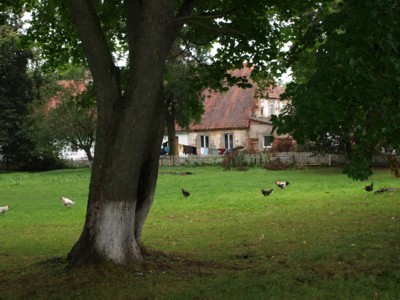
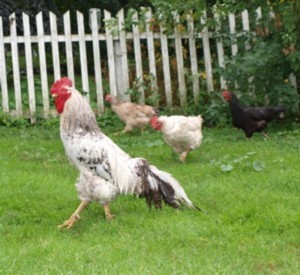 We
cross the Pissa channel, well known as one of the famous jumps at all those
traditional Trakehner fox huntings back than. We pass some tight trees and all
of a sudden the Trakhener Gaite, well known from many photographies, shines in
front of us suggesting a long gone glory. The bus comes to stop in front of the
castle (the „Landstallmeisterhaus“) and we tumble out, somewhat dazed. Ancient
oaktrees have taken over command in the small park in front of the castle. Their
leaves of green are hiding some of the homes behind them. Pictorial and deceptive
in one.
We
cross the Pissa channel, well known as one of the famous jumps at all those
traditional Trakehner fox huntings back than. We pass some tight trees and all
of a sudden the Trakhener Gaite, well known from many photographies, shines in
front of us suggesting a long gone glory. The bus comes to stop in front of the
castle (the „Landstallmeisterhaus“) and we tumble out, somewhat dazed. Ancient
oaktrees have taken over command in the small park in front of the castle. Their
leaves of green are hiding some of the homes behind them. Pictorial and deceptive
in one.
Happy chickens enjoy their life running free in the park and all over the place
– in their middle a proud cock.
Mechanically I have to think of Iwan, our russian travel guide...
The welcoming in the castle is sincere and hearty as can be. Old friends are
hugged and thanks to Ivan Kuznetsov, the german teacher here at school,
communication is not a problem at all. But there are things that don't need to
be translated as speech doesn't matter when emotions take over:
Anja, one of the students at Jansaja Poljana, starts singing
– german
folk songs, to welcome the guests. Her bright
voice is amazing, causing goose skin feeling and more. Have tears been hidden
before, they are not anymore.
Literally borderless emotions.
Moments to live for, I guess.
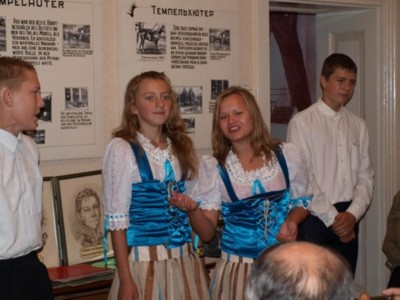
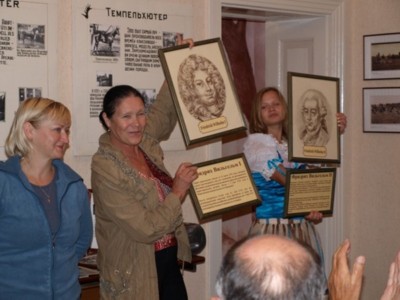 Barely
ever has the tiny schoolroom heard such applause – it wouldn't want to end
anymore.
Barely
ever has the tiny schoolroom heard such applause – it wouldn't want to end
anymore.
It came straight from the hearts.
On the occasion of the german visit the newly created portraits of the various former
Landstallmeister (heads of the Trakehner State Stud) are being introduced to the
public for the very first time. They will vividly add to the samples of the
little museum teaching Trakehner history in the castle.
A brief tour through the little museum concludes the inside visit of the castle,
people spread out and discover the outside area, tracing down what was once
alive and has turned this place into history...
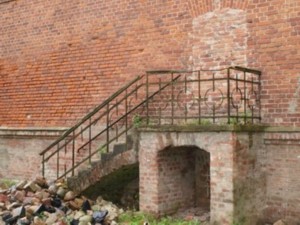
The leftovers from those ancient buildings suggest how mighty and powerful this
place once was. The former hunting horse barn of 150 meters in length has been
turned into a cattle place today, the windows have been covered with plastic.
The former indoor riding arena has been bricked up completely to avoid danger of
collaps. Remaining ruins speak loud – lesser due to their sad existence today
but clearly given their structural formation proving a well thought of
infrastructure of excellence back than. Trakehnen used to be a completely
independent little town of itself with it's own railwaystation, hotel and school.
A historic place risen and blossoming entirely due the glory of horses that made it
famous.
This is histroy to walk.
And it comes with nostalgic feelings.
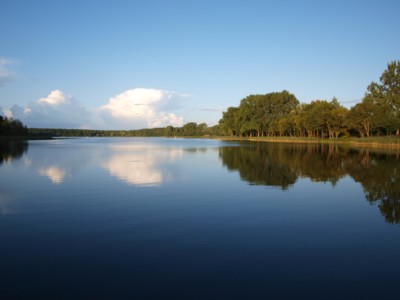 The departure from Trakehnen is dominated by mixed feelings and thoughtfulness.
And certainly noone wants to have missed out on this experience. Since there are
things that speak for themsleves.
The departure from Trakehnen is dominated by mixed feelings and thoughtfulness.
And certainly noone wants to have missed out on this experience. Since there are
things that speak for themsleves.
Impressions we will never forget.
The following excursions to the other various former Trakehner State Studs suddenly
appear in a completely different light. Rastenburg has turned into a polish
State Stud still intact, primarily standing cold blood field horses. Specially
Lisky, also owned by the polish goivernment today, provides for some timless
impressions of horsebreeding how it was back than, how it is still been done today.
The contrast to the private run Romanowski Stud couldn't be any bigger.
Our journey ends in Poland's beautiful Masuria,
the land of the thousand blue lakes. One last time we listen to the hunting horn
of our travel guide Bernd, intoning the old Hymn of East Prussia. What might
appear sappy somewhere else is well placed and authentic in these ancient
prussian woods. The tiny bit of goose skin feeling makes it simply perfect.
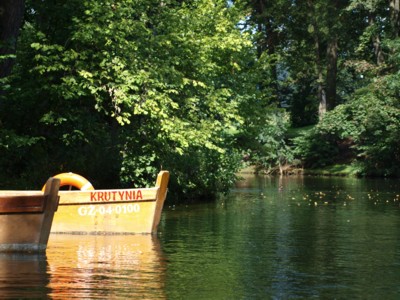
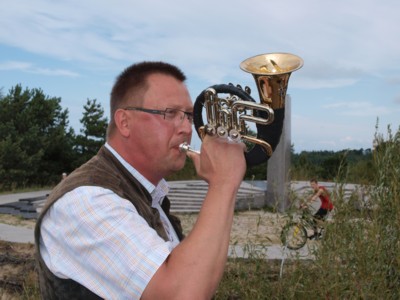
detailed photoalbum containing pictures worth seeing of any of the places
mentioned in this report
home